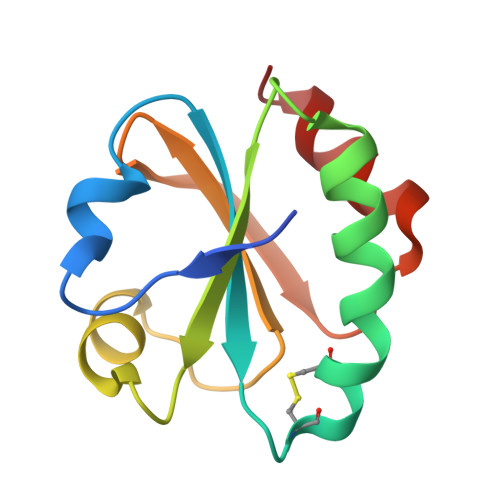The conserved active site proline determines the reducing power of Staphylococcus aureus thioredoxin
Roos, G., Garcia-Pino, A., Van Belle, K., Brosens, E., Wahni, K., Vandenbussche, G., Wyns, L., Loris, R., Messens, J.(2007) J Mol Biol 368: 800-811
- PubMed: 17368484
- DOI: https://doi.org/10.1016/j.jmb.2007.02.045
- Primary Citation of Related Structures:
2O7K, 2O85, 2O87, 2O89 - PubMed Abstract:
Nature uses thioredoxin-like folds in several disulfide bond oxidoreductases. Each of them has a typical active site Cys-X-X-Cys sequence motif, the hallmark of thioredoxin being Trp-Cys-Gly-Pro-Cys. The intriguing role of the highly conserved proline in the ubiquitous reducing agent thioredoxin was studied by site-specific mutagenesis of Staphylococcus aureus thioredoxin (Sa_Trx). We present X-ray structures, redox potential, pK(a), steady-state kinetic parameters, and thermodynamic stabilities. By replacing the central proline to a threonine/serine, no extra hydrogen bonds with the sulphur of the nucleophilic cysteine are introduced. The only structural difference is that the immediate chemical surrounding of the nucleophilic cysteine becomes more hydrophilic. The pK(a) value of the nucleophilic cysteine decreases with approximately one pH unit and its redox potential increases with 30 mV. Thioredoxin becomes more oxidizing and the efficiency to catalyse substrate reduction (k(cat)/K(M)) decreases sevenfold relative to wild-type Sa_Trx. The oxidized form of wild-type Sa_Trx is far more stable than the reduced form over the whole temperature range. The driving force to reduce substrate proteins is the relative stability of the oxidized versus the reduced form Delta(T(1/2))(ox/red). This driving force is decreased in the Sa_Trx P31T mutant. Delta(T(1/2))(ox/red) drops from 15.5 degrees C (wild-type) to 5.8 degrees C (P31T mutant). In conclusion, the active site proline in thioredoxin determines the driving potential for substrate reduction.
Organizational Affiliation:
Department of Molecular and Cellular Interactions, Vrije Universiteit Brussel, Pleinlaan 2, 1050 Brussels, Belgium.














